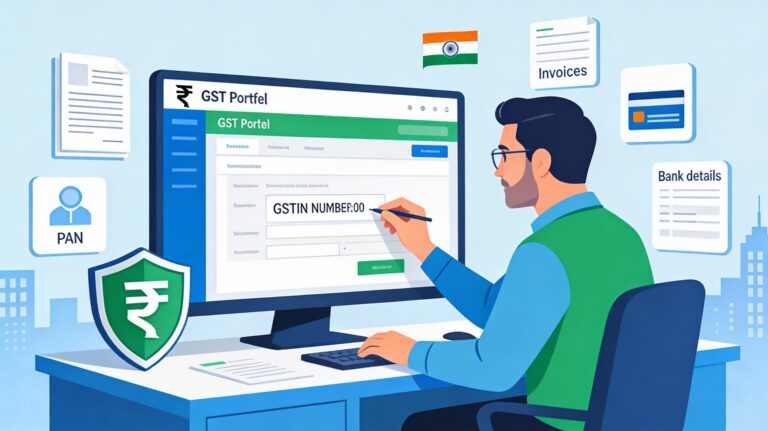
Wrongly enrolled in India’s Employees’ Pension Scheme (EPS)? Your savings could be locked for over a year due to ₹15,000 wage errors and EPFO delays. With 7.71 crore members facing backlogs, discover 2025’s proven refund hacks—from UAN portal tips to Form 3A fixes. This suspenseful guide unveils EPFO’s 2025 rule changes, emotional tolls, and expert strategies to reclaim your funds.
The Employees’ Pension Scheme (EPS) stands as a cornerstone of post-retirement security, promising a steady pension for millions. Yet, in 2025, a hidden crisis lurks for many unsuspecting employees: wrongful EPS enrolment. Trapped in a maze of bureaucratic delays, erroneous deductions, and complex refund processes, workers face a daunting reality—reclaiming misallocated funds can take a year or more. This blog unravels the mystery of EPS errors, offering a step-by-step guide, emotional insights, and expert strategies to navigate this financial limbo. Packed with 2025 EPFO updates, actionable advice, and gripping narratives, this post is your roadmap to reclaiming what’s rightfully yours.
The ₹15,000 Conundrum: Why EPS Eligibility Isn’t for Everyone
The EPS eligibility threshold of ₹15,000 basic wages per month is the heart of this drama. According to EPFO norms, employees earning above this amount at the time of joining are ineligible for EPS membership. Yet, errors abound. Employers, often overwhelmed by compliance demands, mistakenly enroll high-wage earners, diverting 8.33% of their salary into EPS instead of the Employees’ Provident Fund (EPF). This misstep locks funds in a scheme you can’t benefit from, creating a financial quagmire.
Consider Ravi, a 32-year-old software engineer from Bengaluru. Earning ₹25,000 monthly when he joined his first job in 2020, he was wrongly enrolled in EPS. Five years later, during a job switch, he discovered ₹75,000 in EPS deductions—money he couldn’t access for pension benefits due to his ineligibility. Ravi’s story, echoed across India, underscores the stakes: your hard-earned savings, trapped in a system meant to protect you.
The Employer Error: How EPS Mistakes Are Made
Many employees remain unaware that their EPS deductions are amiss until attempting a PF transfer or pension withdrawal. The root cause? Employers failing to verify EPS eligibility or misfiling wages above the ₹15,000 ceiling. With multiple job switches common in India’s dynamic labour market, this error snowballs across companies, complicating refunds.
The EPS ledger then paints a conflicting picture — contributions deducted but ineligible to receive pension benefits, effectively locking those amounts in limbo and unsettling financial plans.
How To Prove Wrongly Enrolled EPS using EPFO Records
To prove that you were wrongly enrolled in the Employees’ Pension Scheme (EPS) using EPFO records, here are the key steps based on 2025 EPFO processes and documentation requirements:
- Check Your EPFO Passbook and UAN Portal for EPS Entries
Log in to the EPFO member portal or UAN portal and download your EPF passbook. Look closely at the EPS contribution entries under each employer. If you were wrongly enrolled, the passbook may show EPS deductions despite your monthly wages being above the ₹15,000 basic wage eligibility threshold. Confirm your salary slips to verify actual wages during that period mismatch with EPS deductions. - Obtain a Clarification Letter from Your Employer
Request your original employer to provide a formal clarification letter stating that you were wrongly enrolled in EPS due to your salary exceeding the eligible threshold. This letter should confirm that no pension scheme contributions should have applied during your tenure. - Get Employer to Submit Revised Form 3A
The employer must file a revised Form 3A (yearly PF and EPS contribution summary) with the EPFO showing zero EPS contribution for your ineligible period. This document is crucial as official evidence from the employer proving the error. - Submit a Joint Declaration Form (Form 11 Composite Declaration)
Together with the employer, file the composite declaration form with the EPFO to update your service and EPS contribution records officially for that period as non-pensionable. - Raise a Grievance with EPFO Online (EPFiGMS)
If corrections aren’t reflected timely, lodge a grievance in the EPFO grievance management system attaching your EPFO passbook, employer clarification letter, revised Form 3A, and Form 11. Follow up regularly. - Verify Service History and EPS Status in the Portal
Confirm on the EPFO portal that your EPS joining/leaving dates have been removed or corrected for that employment period. Also, ensure your wage details reflect the basic wage above ₹15,000, justifying ineligibility. - Use Evidence Like Payslips & Appointment/Relieving Letters
Alongside EPFO records, keep payslips and appointment/relieving letters to establish your actual wages and employment duration.
These records and employer-submitted corrections are the official documentation to prove wrongful EPS enrolment. Once EPFO accepts the correction, the wrongly deducted EPS contributions can be refunded or transferred back to your EPF account.
If difficulties persist, escalate grievances through Ministry of Labour complaint portals or consult EPFO commissioners. Persistent follow-up is essential due to EPFO processing delays.
This structured approach using EPFO records and employer documentation is the best way to prove and rectify wrongful EPS enrolment in 2025 India.
Hidden GSTN Update: How to Beat ‘Schema Validation Failed’ in GSTR-7 Filing
The ₹2 Lakh Cash Rule: What You Need to Know to Avoid Hefty Tax Penalties
What is HDFC Debit Card EMI & How Does It Work? Is Your Debit Card EMI-Ready?
Indian Stock Market Trends: Sensex, Nifty Insights & Top Picks for December 26, 2025
Why does EPFO take over a year to process EPS correction cases
EPFO often takes over a year to process EPS correction cases due to several interlinked reasons:
- Employer Dependency for Documentation: EPFO requires employers to submit clarifications, revised Form 3A, and jointly approve correction claims. Delays or lack of cooperation from employers dramatically slow down processing since EPFO cannot proceed without official employer input and confirmations.
- Massive Backlogs and High Volume: EPFO handles millions of EPS cases and corrections nationwide. The sheer volume of pending applications, combined with limited manpower and legacy manual processes in some offices, causes significant processing backlogs.
- Complex Verification and Reconciliation: EPS correction involves cross-verifying wage records, employment history, basic pay thresholds, and service continuity across multiple employers. This complexity requires detailed scrutiny to avoid errors, which takes time.
- System and Technical Delays: EPFO’s IT systems periodically update member IDs, wage records, and pension computations. Delays or mismatches in data synchronization can stall correction processing until resolved.
- Regulatory/Policy Constraints: EPFO follows strict procedural guidelines and Supreme Court timelines, sometimes requiring multiple rounds of grievance redressals and legal compliance checks before final approvals.
- Government Pension Fund Constraints: Large outstanding dues from the Central Government towards EPFO's pension fund and cash flow concerns affect fund disbursement schedules, indirectly impacting refund timelines.
- Multiple Levels of Approval: From field offices to zonal offices and EPFO headquarters, EPS correction approvals involve layered authorization, which adds procedural delays.
Hence, even though a simpler EPF withdrawal claim may take about 20 days, EPS corrections dealing with eligibility errors and fund reallocations typically take anywhere from 12 to 18 months or more in 2025 India due to these compounded operational and systemic reasons. Persistent follow-up with EPFO and employer cooperation remain essential to expedite the process.
Documents Required To Speed Up The EPS Refund Claim Process
To speed up your EPS refund claim process with EPFO in 2025, it is essential to gather and submit the correct documents promptly. The exact documents that help accelerate your claim include:
- Filled Claim Form 10C (for EPS refund or scheme certificate application) duly signed and, if offline, attested by the employer or designated authority.
- EPF Passbook or UAN Statement showing EPS deductions.
- Employer Clarification Letter stating the erroneous EPS enrolment (especially if your wages exceeded the ₹15,000 threshold).
- Revised Form 3A submitted by your employer showing zero EPS contribution for the wrongly enrolled period.
- Salary Slips or Proof of Salary confirming that your basic wages were above ₹15,000 during the relevant period.
- Proof of Identity and Address, such as Aadhaar card and PAN card.
- Bank Account Details with a blank/cancelled cheque for seamless refund transfer.
- Proof of Date of Birth for service verification.
- If applicable, service termination/relieving letter from the employer.
- Joint Declaration or Form 11 (updated) showing corrected EPS membership status.
Having these documents ready and correctly attested helps EPFO verify your claim swiftly, cutting down verification delays that commonly extend refund timelines beyond a year. Additionally, submitting your claim through the online EPFO portal and regularly following up can enhance processing speed.
In summary, the combo of employer-issued proof of error, official EPFO passbook records, salary evidence, complete identity documentation, and the proper claim forms is key to expediting the EPS refund process in 2025 India.
How to Reclaim Your EPS Money: A Step-by-Step Guide
- Verify your EPS eligibility status via the UAN portal and EPF passbook.
- Request a formal letter from the original employer stating the erroneous EPS enrolment due to wages exceeding ₹15,000.
- Raise a grievance on EPFiGMS, submitting all supporting documents including pay slips, passbook entries showing EPS deductions, and rejection letters from EPFO if any.
- Follow up persistently through the EPFO grievance portal and local EPFO offices in person if required.
- Once approved, the EPS amount is transferred back into your EPF account for seamless withdrawal or transfer.
This approach, while daunting, is the strongest path to unlocking your trapped money.
How will the recent 2025 EPFO rule changes affect EPS refund timeline
The recent EPFO rule changes in 2025 are expected to have a mixed but overall positive impact on EPS refund timelines, though some challenges remain:
- Streamlined Employer Compliance Deadlines:
Employers were required to upload detailed wage and clarification data by January 31, 2025, and provide explanations requested by EPFO by January 15, 2025. This push aims to reduce delays caused by employer non-cooperation in submitting correct EPS-related data, thus potentially speeding up many correction and refund cases that were stuck waiting on employer inputs. - Simplification of Overlapping Service Periods in PF Transfers:
A major 2025 directive instructs EPFO regional offices not to reject PF transfer claims solely due to overlapping service periods, recognizing legitimate administrative or career transition reasons. This change will reduce claim rejections and consequent delays linked to EPS refund processing in cases where overlapping employment histories confused the records. - Better IT Integration and Centralized Payment Systems:
Plans to implement the Centralized Pension Payment System (CPPS) and ongoing IT modernization (e.g., CITES 2.01 rollout) will improve data synchronization between EPFO offices and banks. Enhanced transparency and smoother pension payments might indirectly reduce administrative drag on EPS refund cases in the long run. - New Eligibility Rules and Awareness:
The 2025 rule enforcing at least 10 years of service for EPS pension eligibility adds clarity. While not directly shortening refund timelines, it helps employees and employers better identify who qualifies, which can reduce erroneous enrolments and complicated refund claims in future. - Persistent Challenges Remain:
Despite these improvements, fundamental delays from backlogs, layered approvals, and varying employer cooperation will still cause many EPS corrections and refunds to take 12-18 months or more. EPFO continues to evolve processes, but real-world timelines reflect administrative and technical complexity.
Recent 2025 EPFO rule changes mostly target reducing employer-related bottlenecks, simplifying transfer rejection criteria, and modernizing IT systems to speed up EPS correction and refund processing. While these will gradually shorten timelines and improve cases where employer delays cascaded, entrenched procedural and systemic factors mean refunds will still often require many months before resolution. Proactive employee follow-up and employer collaboration remain key to faster outcomes.
Steps To Prevent Future EPS Enrolment Errors
To prevent future EPS enrolment errors, especially in the Indian context for 2025 and beyond, take these proactive steps:
- Know Your Eligibility Clearly
Understand the basic wage threshold of ₹15,000 per month. If your basic salary exceeds this, you are ineligible for EPS enrolment. Confirm this with your HR before joining or during salary revisions. - Review Form 11 Carefully Before Submission
Form 11 declares whether EPS applies. Ensure your employer fills this accurately at the time of joining or on salary changes. Retain copies for your records and verify all submitted details, particularly wages and EPS enlistment status. - Regularly Monitor Your EPF Passbook and UAN Portal
Frequently check your EPF passbook and UAN member portal for EPS contribution entries. Early detection of erroneous EPS deductions can prevent long-term complications. - Communicate with Employers Proactively
Request detailed salary breakdowns and confirmation of EPS membership status when joining or changing jobs. Encourage employers to follow the latest EPFO rules and submit accurate data. - Maintain Complete Salary and Employment Records
Keep organized records of payslips, appointment letters, salary structures, and relieving documents. These are vital proofs if you need to challenge or correct enrolment errors later. - Engage Early with EPFO Using Grievance Portal
If discrepancies appear, immediately raise grievances via EPFO’s online grievance management system to initiate correction proceedings promptly. - Seek Expert Advice When Needed
Consult pension experts or legal advisors to audit your EPF and EPS accounts periodically, especially during job changes or major salary revisions.
Taking these decisive, informed steps will sharply reduce your risk of wrongful EPS enrolment and protect your pension rights going forward under EPFO’s 2025 frameworks.
Emotional Toll: Between Hope and Endless Wait
For many, these delays are not just procedural; they cast a long emotional shadow. The money deducted, often from modest salaries, represents hard-earned savings and future security. Waiting for justice feels like financial punishment, breeding anxiety, distrust in institutions, and pressing hardships for families relying on timely pension benefits.
Expert Tips: Accelerate Your EPS Refund Journey
- Maintain meticulous records: Keep payslips, EPF passbooks, UAN statements, and employer communications handy.
- Engage with employer HR proactively to secure necessary documentation.
- Use EPFO’s online portal smartly: Track grievances regularly to prevent oversight.
- Consult pension experts or legal advisors if cases stagnate beyond a year.
- Network with peers online in pension forums for practical advice and emotional support.
These strategies can transform a taxing process into a manageable quest.
Final Thought: Claim Your Right with Persistence and Patience
Being wrongly enrolled in EPS is an unexpected financial pitfall, but knowledge and structured action are your best allies. The road to reclaiming your money may be long and fraught with red tape, but it is a fight worth undertaking.
In India’s evolving social security landscape, assert your rights, engage with EPFO constructively, and never lose sight of your rightful pension security. After all, your hard-earned money and peace of mind deserve nothing less






























